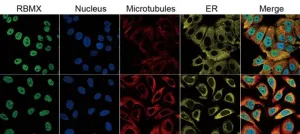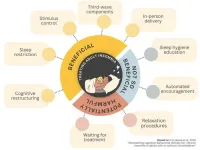(Press-News.org) Deaths from breast cancer dropped 58% between 1975 and 2019 due to a combination of screening mammography and improvements in treatment, according to a new multicenter study led by Stanford Medicine clinicians and biomedical data scientists.
Nearly one-third of the decrease (29%) is due to advances in treating metastatic breast cancer —a form that has spread to other areas of in the body and is known as stage 4 breast cancer or recurrent cancer. Although these advanced cancers are not considered curable, women with metastatic disease are living longer than ever.
The analysis helps cancer researchers assess where to focus future efforts and resources.
“We’ve known that deaths from breast cancer have been decreasing over the past several decades, but it’s been difficult or impossible to quantify which of our interventions have been most successful, and to what extent,” said Jennifer Caswell-Jin, MD, assistant professor of medicine. “This type of study allows us to see which of our efforts are having the most impact and where we still need to improve.”
Caswell-Jin and Liyang Sun are co-first authors of the study, which was published Jan. 16 in the Journal of the American Medical Association. Sylvia Plevritis, PhD, professor and chair of biomedical data science, and Allison Kurian, MD, MSc, professor of medicine and of epidemiology and population health, are co-senior authors.
The study was a collaborative effort by a national consortium of researchers called CISNET, or the Cancer Intervention and Surveillance Modeling Network. CISNET was established in 2000 by the National Cancer Institute to understand the impact of cancer surveillance, screening and treatment on incidence and mortality. Doing so requires sophisticated computer algorithms capable of modeling the natural course of the disease and the typical treatment paths of individual patients, then translating that information to population-level data collected by the national Surveillance, Epidemiology, and End Results Program, or SEER registry, from 1975 to 2019.
The study is the third in a trio of papers from CISNET published since 2005 that assess the relative contributions of regular screening and treatment advances on breast cancer deaths. The previous two papers informed national guidelines and helped cancer researchers focus their efforts on the most intractable problems.
“Twenty years ago, there was a question whether routine screening mammography actually decreased the number of deaths from breast cancer,” Plevritis said. But in 2005, she and other CISNET researchers published a paper in the New England Journal of Medicine that conclusively demonstrated that screening was responsible for anywhere from 28% to 65% (different models came up with varying degrees of impact) of the reduction in mortality by 2000 between 1975 and 2000.
The second paper, published in 2018 in the Journal of the American Medical Association, highlighted the differences in treatment responsiveness and survival outcomes among women with differing breast cancer subtypes from 2000 to 2012 — pinpointing subgroups with poorer survival.
“We found that, while screening still had an important impact, most of the decline in annual deaths was due to improvements in treating early-stage breast cancer based on each cancer’s molecular profile,” Plevritis said.
The current study is the first to explicitly include patients with metastatic breast cancer in its models. The finding that 29% of the decrease in mortality is due to advances in treating metastatic breast cancer both surprised and gratified the researchers.
“Initially, we assumed that treatment of advanced disease was unlikely to make a significant contribution to the declines in mortality we documented in the previous two papers,” Caswell-Jin said. “But our treatments have improved, and it’s clear that they are having a significant impact on annual mortality.”
The CISNET researchers used four computer models to assess the SEER data from 1975 to 2019 — one developed at Stanford Medicine in the Plevritis Lab, one by researchers at the Dana-Farber Cancer Institute, one at MD Anderson Cancer Center, and another jointly developed by researchers at the University of Wisconsin and Harvard Medical School. The four models came up with remarkably similar estimates for the impact of each intervention: screening mammography, treatment of early-stage (stages 1, 2 or 3) breast cancer and treatment of metastatic breast cancer.
The models reproduced the decline in mortality in breast cancer known from SEER data, from 48 per 100,000 women dying of breast cancer each year in 1975 to 27 per 100,000 in 2019 — a decrease of about 44%. The models arrived at a larger estimated reduction in mortality of about 58% because the incidence of breast cancer has risen during the same period and more women would have died had screening and treatments not improved.
The models concluded that about 47% of this reduction in mortality is the result of improved treatments for early-stage breast cancer, and about 25% is attributed to screening mammography. The remainder, or about 29%, is due to improvements in treating metastatic disease.
“Designing the new model, which had to account for individuals with non-metastatic cancer who underwent treatment but later progressed to metastatic cancer, and who may have been treated with multiple drugs over the course of their disease, was extremely complex,” Plevritis said. “It took about four years. But it was really satisfying when we were able to validate the model’s behavior and see that all four models from different institutions, which used the new model inputs in different ways, delivered consistent findings. The models not only make sense, but also produce meaningful insights.”
The impact of treating metastatic disease is exemplified by the increases in median survival time after metastasis: Patients diagnosed in 2000 with metastatic disease lived an average of 1.9 years versus an average of 3.2 years for those diagnosed in 2019. Survival time varies by subgroup status, however. Patients with what are known as estrogen receptor-positive and HER2 positive cancers saw an average increase in survival time of 2.5 years. Those with estrogen receptor-positive and HER2-negative cancers lived an average of 1.6 years longer, but those with cancers that are estrogen receptor-negative and HER2-negative lived about 0.5 years longer in 2019 than in 2000.
“It was meaningful as a breast oncologist to spend time with this history and see real progress over the past decades,” Caswell-Jin said. “There is much more work to be done; metastatic breast cancer isn’t yet curable. But it is rewarding to see that advances have made a difference in these numbers,” she added. “Our scientific and clinical work is helping our patients live longer, and I believe deaths from breast cancer will continue to steadily decline as innovation continues to grow.”
Researchers from MD Anderson Cancer Center, the Dana-Farber Cancer Institute, the University of Wisconsin-Madison School of Medicine and Public Health, the National Institutes of Health, the Albert Einstein College of Medicine, Harvard Medical School, Georgetown University, and the Georgetown-Lombardi Institute for Cancer and Aging contributed to the study.
The study was funded by the National Institutes of Health (grants U01CA253911 and U01CA199218).
END
Metastatic breast cancer treatments have aided decline in deaths, Stanford Medicine-led study finds
Treatment of metastatic disease is responsible for nearly one-third of the decrease in annual deaths from breast cancer from 1975 to 2019, according to a Stanford Medicine-led study
2024-01-17
ELSE PRESS RELEASES FROM THIS DATE:
Aberrant RBMX expression relevant for cancer prognosis and immunotherapy response
2024-01-17
“In the future, targeting of RBMX may be a novel method in cancer therapy.”
BUFFALO, NY- January 17, 2024 – A new research paper was published in Aging (listed by MEDLINE/PubMed as "Aging (Albany NY)" and "Aging-US" by Web of Science) Volume 16, Issue 1, entitled, “Aberrant RBMX expression is relevant for cancer prognosis and immunotherapy response.”
Cancer accounts for the highest rates of morbidity and mortality worldwide. RNA binding motif protein X-linked (RBMX) is a nuclear ...
Higher measurement accuracy opens new window to the quantum world
2024-01-17
A team at HZB has developed a new measurement method that, for the first time, accurately detects tiny temperature differences in the range of 100 microkelvin in the thermal Hall effect. Previously, these temperature differences could not be measured quantitatively due to thermal noise. Using the well-known terbium titanate as an example, the team demonstrated that the method delivers highly reliable results. The thermal Hall effect provides information about coherent multi-particle states in quantum materials, based on their interaction with lattice vibrations (phonons).
The laws of quantum physics apply to all materials. However, in so-called ...
National collaborative for health equity roundtable: a call for unity and the power of racial healing
2024-01-17
A new Roundtable discussion in the peer-reviewed journal Health Equity explores the results of a poll conducted by the National Collaborative for Health Equity (NCHE), called the “Heart of America Annual Survey.” The survey found that more than 80% of respondents want a national leader that unifies rather than divides us, suggesting that there is a readiness in the country to put polarization and division behind us so that we can solve our collective and common challenges and problems. Click here to read the Roundtable now.
Moderating ...
New project to improve modeling of climate change
2024-01-17
Jingrui He, professor of information sciences at the University of Illinois Urbana-Champaign, has been awarded a two-year, $600,000 grant from the IBM-Illinois Discovery Accelerator Institute to improve modeling climate change and its impact across multiple application domains. He and a team of researchers from the University of Illinois and IBM will build Climate Runtime, a computational framework integrating cutting-edge capabilities from climate foundation models and multimodal fusion. This framework will allow for accurate prediction and quantification of weather and climate events and their impact in areas such as finance ...
Climate change isn’t producing expected increase in atmospheric moisture over dry regions
2024-01-17
Contacts:
David Hosansky, UCAR and NSF NCAR Manager of Media Relations
hosansky@ucar.edu
720-470-2073
Audrey Merket, UCAR and NSF NCAR Science Writer and Public Information Officer
amerket@ucar.edu
303-497-8293
The laws of thermodynamics dictate that a warmer atmosphere can hold more water vapor, but new research has found that atmospheric moisture has not increased as expected over arid and semi-arid regions of the world as the climate has warmed.
The findings are particularly puzzling because climate models have been predicting ...
New research highlights unprecedented targeted approach to treating triple-negative breast cancer
2024-01-17
Cleveland Clinic researchers have successfully developed a therapeutic peptide that blocks aggressive cancer cells from multiplying rapidly. The results highlight a potential new strategy for developing targeted treatments for triple-negative breast cancer, which currently has no approved options.
Targeted drugs attack cancer cell functions directly, offering a more precise approach to complement broader treatments like chemotherapy. A research team led by Ofer Reizes, PhD, and Justin Lathia, PhD, designed a peptide therapeutic that disrupts the molecular processes behind aggressive cancer growth when delivered into cells.
The ...
ASBMB names Mona V. Miller as next executive officer
2024-01-17
The American Society for Biochemistry and Molecular Biology today named Mona V. Miller its next chief executive officer, effective April 1.
Miller is an experienced association leader with significant experience in strategic planning, advocacy and fundraising. Most recently, she was CEO of the American Society of Human Genetics. Before that she held multiple high-level positions at the Society for Neuroscience.
Miller said she was drawn to the ASBMB because “scientifically, biochemistry and molecular biology is at the forefront of knowledge that is transforming health and society.”
She said she looks forward to “focusing on the pivotal ...
Streamlining cognitive behavioral therapy for chronic insomnia
2024-01-17
A combination of cognitive and behavioral strategies, ideally delivered in person by a therapist, maximizes the benefits of cognitive behavioral therapy for insomnia (CBT-I), according to new research. CBT-I is a form of talk therapy, which can be delivered in person or through self-help guides. By analyzing 241 studies, involving over 30,000 adults, researchers identified the most beneficial components of CBT-I. These included: cognitive restructuring, third-wave components, sleep restriction, stimulus control and in-person delivery. Self-help with human encouragement could also be beneficial, while waiting for active treatment and enforcing ...
Prenatal opioid exposure and immune-related conditions in children
2024-01-17
About The Study: Prenatal opioid exposure was associated with an increased risk of infection, eczema and dermatitis, and asthma, but not allergies and anaphylaxis or autoimmune conditions in this study of 401,000 neonates. These findings highlight the importance of further study of opioid-induced immune changes during pregnancy, the potential impact on long-term health in exposed children, and the mechanisms of opioid-induced immune dysregulation.
Authors: Erin Kelty, Ph.D., of the University of Western Australia in Crawley, Western Australia, ...
Comparative effectiveness of psychotherapy vs antidepressants for depression in heart failure
2024-01-17
About The Study: In this comparative effectiveness trial of behavioral activation psychotherapy (BA) and antidepressant medication management (MEDS) in 416 patients with heart failure experiencing depression, both treatments significantly reduced depressive symptoms by nearly 50% with no statistically significant differences between treatments. BA recipients experienced better physical health-related quality of life, fewer emergency department visits, and fewer days hospitalized. The study findings suggest that patients with heart failure could be given the choice between BA or MEDS to ameliorate depression.
Authors: Waguih ...
LAST 30 PRESS RELEASES:
Research alert: Spreading drug costs over the year may ease financial burden for Medicare cancer patients
Hospital partnership improves follow up scans, decreases long term risk after aortic repair
Layered hydrogen silicane for safe, lightweight, and energy-efficient hydrogen carrier
Observing positronium beam as a quantum matter wave for the first time
IEEE study investigates the effects of pointing error on quantum key distribution systems
Analyzing submerged fault structures to predict future earthquakes in Türkiye
Quantum ‘alchemy’ made feasible with excitons
‘Revoice’ device gives stroke patients their voice back
USF-led study: AI helps reveal global surge in floating algae
New method predicts asthma attacks up to five years in advance
Researchers publish first ever structural engineering manual for bamboo
National poll: Less than half of parents say swearing is never OK for kids
Decades of suffering: Long-term mental health outcomes of Kurdish chemical gas attacks
Interactional dynamics of self-assessment and advice in peer reflection on microteaching
When aging affects the young: Revealing the weight of caregiving on teenagers
Can Canada’s health systems handle increased demand during FIFA World Cup?
Autistic and non-autistic faces may “speak a different language” when expressing emotion
No clear evidence that cannabis-based medicines relieve chronic nerve pain
Pioneering second-order nonlinear vibrational nanoscopy for interfacial molecular systems beyond the diffraction limit
Bottleneck in hydrogen distribution jeopardises billions in clean energy
Lung cancer death rates among women in Europe are finally levelling off
Scientists trace microplastics in fertilizer from fields to the beach
The Lancet Obstetrics, Gynecology, & Women’s Health: Taking paracetamol during pregnancy does not increase risk of autism, ADHD or intellectual disabilities, confirms new gold-standard evidence review
Taking paracetamol during pregnancy does not increase risk of autism, ADHD or intellectual disabilities
Harm reduction vending machines in New York State expand access to overdose treatment and drug test strips, UB studies confirm
University of Phoenix releases white paper on Credit for Prior Learning as a catalyst for internal mobility and retention
Canada losing track of salmon health as climate and industrial threats mount
Molecular sieve-confined Pt-FeOx catalysts achieve highly efficient reversible hydrogen cycle of methylcyclohexane-toluene
Investment in farm productivity tools key to reducing greenhouse gas
New review highlights electrochemical pathways to recover uranium from wastewater and seawater
[Press-News.org] Metastatic breast cancer treatments have aided decline in deaths, Stanford Medicine-led study findsTreatment of metastatic disease is responsible for nearly one-third of the decrease in annual deaths from breast cancer from 1975 to 2019, according to a Stanford Medicine-led study




